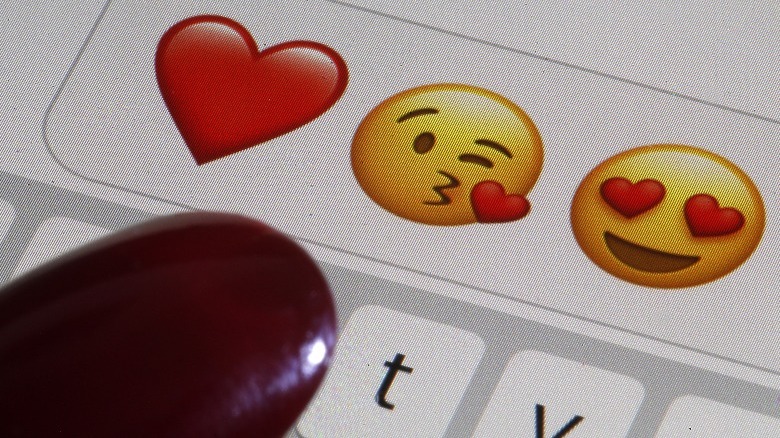Why Flirting Isn't Always Easy To Recognize, According To Experts
Flirting can be one of the most thrilling yet confusing experiences one can have. If used successfully, flirting can be a fun, rom-com-worthy interaction that leaves you feeling on cloud nine. However, most flirting goes unnoticed because our signals aren't always so evident. Flirting is a language of its own and is a learned behavior that requires knowledge, experience, and practice.
One study conducted by the University of Kansas revealed that only a small percentage of individuals between the ages of 18 and 48 were able to accurately detect flirting. In the study, only 18% of women were able to recognize when men were flirting, while only 36% of men were able to recognize women flirting.
Flirting is not a universally understood behavior, so it should be considered that what works successfully for one person may not for another. If you struggle with flirting, whether that's recognizing it or avoiding it altogether, fret not, because you aren't alone. "The next time you find yourself trapped in the enigmatic world of flirting, remember that even the most skilled detectives might struggle to crack the code," relationship expert Chris Gillis told The List. "Life is too short to let the complexities of flirtation pass you by, so embrace the uncertainty, laugh at the hilarity, and keep your heart open to the possibility of love amidst the confusion."
You don't know each other well enough
Flirting can be especially difficult to decipher when you're interacting with a new person whom you don't know well. Since there is no foundation to reference, it may inhibit our ability to accurately detect an increase in flirty behavior. Licensed clinical psychotherapist Dr. Heather England explained, "Flirting is very nuanced and can be easily overlooked especially if the person is a stranger, because if you don't know them well enough, you can miss the behavioral cues that they are flirting with you."
For instance, maybe there's someone at the gym who you've begun having regular interactions with, a barista who seems to care about all the details of your day, or even a stranger you hit it off with on the bus. These are classic scenarios that send us home wondering, 'Was there something there, or was I just imagining things?'
In uncertain instances like this, we often leave without moving the situation toward romance because we're second-guessing the situation. Unless you or the other party is explicit in wanting to pursue a date, there's no surefire way to pick up on behavioral cues, especially in the moment.
It might just be friendliness
Some people are naturally flirty without realizing it. According to relationship counselor Sam Holmes, "Flirting and friendliness can often go hand in hand, blurring the lines between the two. Friendly people naturally possess warmth and engaging conversation skills, which can be mistaken for flirtation." Something as simple as remembering small details about you, always smiling when you're around, or a compliment, are all acts of friendliness that can easily be confused for flirting.
Confusing friendliness for flirting is so common that it is frequently a theme in movies and shows. In an episode of "The King of Queens," for example, Doug is convinced that a waitress is extremely flirty towards him and has a crush on him. She remembers his order, leaves notes on his checks, and even goes as far as asking his friend Deacon about him. Come to find out, Doug eventually sees that the waitress gives all of her customers the same treatment as him and soon realizes she wasn't flirting with him after all.
The context and setting of the interaction are two especially important components to consider when deciphering if someone is actually flirting or just being friendly. People who work in the service industry are encouraged to be kind and inviting because they're representing a business and hoping to win returning customers. Holmes emphasized, "It's important to consider the context, body language, and overall intentions before jumping to conclusions."
The other person just wants an ego boost
There are also people out there who flirt simply to get an ego boost and validation without any intention of pursuing anything romantically. This behavior doesn't just apply to singles either; it can even apply to those who are already in committed relationships. According to relationship counselor Sam Holmes, "Sometimes, people who are already in committed relationships may engage in harmless flirting without any intention of infidelity." He explained, "Flirting can serve as a confidence booster or a way to playfully interact with others. However, it doesn't necessarily indicate a desire to pursue something beyond harmless banter." People who are prone to this kind of flirting are likely in unfulfilling relationships, have recently ended a relationship, or are seeking validation for other reasons.
Dating apps and social media have drastically changed flirting by making it more easily accessible than ever before. To make matters even more confusing, in a study conducted by LendEDU, 44.44% of millennials use dating apps for "confidence-boosting procrastination." Dating apps are a great quick fix to fulfill flirting needs without any commitment, but this may come at the expense of the other person's time. So, if you're ever wondering why the person you've been talking to on a dating app always seems to be busy or never asks you on a date, it's possible they were only chatting for an ego boost.
Technology could be to blame
Technology has given us the luxury of finding partners through dating apps, the ability to slide into each others' DMs, and the ease of low-stakes communication via text. However, it has also made flirting slightly more confusing. Dating expert Chris Gillis even went as far as describing today's dating as "a flirtation black hole."
There are so many technological tools that have become commonplace for flirting, so it's no wonder we're getting our wires crossed. Gillis explained, "In the digital age, where emojis, GIFs, and memes reign supreme, flirting has taken on an entirely new form. It's a treacherous battlefield where one misplaced winky face can transform an innocent chat into a hotbed of confusion."
Something as simple as responding to someone's Instagram story with a fire emoji can be considered a way of flirting, or commenting with a heart-eye emoji reaction on a new Instagram photo can also be received as romantic interest even if that was not the intention. Either way, it's recommended that we avoid subtlety when it comes to flirting. The best method for making your interest known is communicating in person and by explicitly using the word 'date' when asking someone out.
Fear of jeopardizing your friendship
Wanting to take a friendship to the next level can be super intimidating. This may be someone you've known for a long time and have built a good relationship with, so the thought of acting on your feelings may be nerve-wracking, especially if there's a chance your feelings are not reciprocated. Trying to make a friendship romantic can completely change its dynamic, possibly leading to awkwardness or falling outs. This can deter one friend from pursuing the other out of fear that they'll lose that person.
When you've been friends with someone for years and begin to show romantic interest, it may catch the other person completely off guard because they haven't considered anything more than a friendship with you. Believe it or not, Dr. Heather England tells us, "Flirting is even easier to miss if the person is a friend or already in a relationship because you don't expect them to flirt with you. Because your brain isn't expecting that, you miss the signals. It's similar to a radio; because you don't expect it, your brain isn't tuned into the right channel to pick up on the frequency of their flirting."
When you're the one flirting with a friend, it's important to communicate your feelings clearly to avoid confusion and to prepare yourself for unrequited romantic feelings.
It could be due to low self-esteem
Flirting is intimidating, but if you struggle with low self-esteem, it can be nearly impossible to detect. Those with low self-esteem struggle to find value in themselves and may be convinced that they aren't good enough for anyone, automatically dismissing any signs of flirting.
Mental health counselor and relationship expert Candice Burch shared with The List, "They might not believe that someone would be interested in them to begin with. Therefore, they find it difficult to recognize when someone is flirting with them, no matter how obvious it may be to the layperson." Insecure folks have wired their brains to deflect any information that counters their beliefs about themselves. This typically stems from issues like childhood trauma, a difficult upbringing, or bullying. Ultimately, the way you view yourself makes all the difference in interpreting what someone says about you.
To paint a picture, Burch shares real-life insight based on a previous client's experience with low self-esteem. "People would flirt with her all of the time but she never realized it until one of her friends or family members pointed it out. Even then she was in disbelief," Burch explained. "When a man would ask for her number or ask her out on a date she would be shocked because of the negative core belief that she had about herself."
Fear of rejection
One of the biggest deterrents when it comes to flirting with someone is the fear of rejection. According to a study conducted by eharmony and Relate, 60% of men admitted that the fear of rejection was one of their biggest insecurities when dating. There's no doubt that rejection stings, especially when it comes to shooting your shot. We may go out of our way to avoid the possibility of rejection because it makes us feel insecure, ashamed, or embarrassed. However, as the saying goes: "No risk, no reward."
One bad experience with romantic rejection may be enough to completely turn you off from putting yourself out there and potentially meeting your future partner. Relationship counselor Sam Holmes explained, "Flirting can be intimidating, leading some individuals to mask their intentions or exhibit mixed signals. Fear of rejection, uncertainty, or previous negative experiences can make individuals hesitant to fully express their interest. This can manifest as ambiguous flirting, making it harder to discern their true intentions."
Those who fear rejection will use ambiguous flirting to test the waters. For instance, if someone has already given you a compliment or asked you out for a one-on-one date, they might try to brush it off as a joke or downplay the sincerity of it depending on your reaction.
It's too subtle
Oftentimes, flirting goes unnoticed because of how subtle it can be. Dropping little hints that you're interested in someone may feel like a big step for you, but these clues may not be received the way you intended, or even recognized as flirting for that matter. Relationship therapist and life coach Nia Williams shared with The List, "Flirting often involves subtle, non-verbal cues such as body language, eye contact, and facial expressions. These signals can be easily misinterpreted or missed altogether, especially if we're not attuned to them or if the person flirting is skilled at being discreet." Again, context also plays a major role in how flirting is interpreted. For example, if someone is trying to flirt with you at work, there's a possibility that you are so focused on the task at hand that you don't even notice the compliment you just received.
The age of social media has also made subtle flirting all the more difficult to read. One example of subtle flirting that has become popularized over the years is the concept of sliding into a person's DMs or reacting to their Instagram story with an emoji. But these small gestures can be easily missed because they don't necessarily register as gestures that required much effort or care.
Cultural differences
In terms of flirting, the cultural spectrum is rather polarized, so we might need to look into how people flirt in different parts of the world. According to relationship counselor Sam Holmes, "Flirting norms and cues can vary across cultures and even regions. What may be seen as flirting in one context could be perceived as simply being polite in another. It's crucial to be mindful of cultural differences when interpreting flirting behaviors what may seem obvious in one culture might be subtle or even nonexistent in another."
For example, In Iranian cultures, it is not advised to show public displays of affection — instead, this is usually done in private. Conversely, in Spanish cultures, it is often women who make the first move and do the flirting as opposed to men. Non-verbal cues such as eye contact, smiling, and physical touch are also forms of flirting that vary widely across different cultures. So instead of being a sign of romantic interest, friendly or flirty-seeming body language may just be the norm in that culture's communication style.









